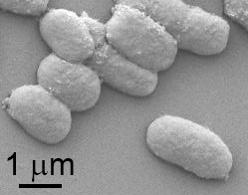Jun 12 2019
Biorefinery technology uses biomass as a feedstock and changes it to energy and other useful by-products. It is gaining attention as an eco-friendly and sustainable technology to overcome the issue of fossil fuel depletion. However, the kinds of biomass that can be employed for this technology are very narrow. Starch crops like corns are utilized as biomass (mostly glucose), but they are consumed by microorganism without difficulty. Such processes have restrictions in sustaining the growing demands of bioproducts, for instance, the consumption of food resources and narrow cultivation capabilities.
 Professor Gyoo Yeol Jung and his research team utilized algae that grow three times faster than starch crops and succeeded in producing biofuel and biochemicals. They developed a new artificial microorganism as a microbial platform for the biorefinery of brown macro-algae which is possible to accelerate biochemical production rate. (Image credit: POSTECH, Seoul National University)
Professor Gyoo Yeol Jung and his research team utilized algae that grow three times faster than starch crops and succeeded in producing biofuel and biochemicals. They developed a new artificial microorganism as a microbial platform for the biorefinery of brown macro-algae which is possible to accelerate biochemical production rate. (Image credit: POSTECH, Seoul National University)
To handle such restrictions, the collaborative research team of POSTECH and Seoul National University created a new microorganism, which they christened as Vibrio sp. dhg. In their research, they effectively showed that Vibrio sp. dhg can be a capable microbial platform for the biorefinery of brown macro-algae which can substitute starch-crop biomass. Their study was published recently in the distinguished journal, Nature Communications on June 6th, 2019.
On-going efforts on investigating the utilization of non-edible biomass are being done and brown macroalgae have been recommended as an alternative feedstock. Brown macro-algae grow two to three times quicker than the starch crops and only need seawater and light to grow. They are only eaten in a few countries like Korea. Due to these plus points, they seem to be a rational alternative option. However, no industrial microorganism is available that can easily metabolize polysaccharides such as alginic acid in algae and it was hard to formulate a process for utilizing algae as biomass.
To solve this issue, Prof. Gyoo Yeol Jung and his research team at POSTECH and Prof. Sang Woo Seo and his research group at Seoul National University effectively created a new microorganism, Vibrio sp. dgh that can quickly metabolize alginic acid in algae and genetic engineering methods enhanced for this new microorganism based on omics analysis. Furthermore, they succeeded in forming biorefinery processes that directly create 2,3-butanediol (raw material for plastics), lycopene (physiologically active substance), ethanol (biofuel), and other chemical products by artificially exploiting the metabolic pathway of Vibrio sp. dhg.
Particularly, the new artificial microorganism they learned has many benefits and great potential for future usage. For example, Vibrio sp. dhg can not only use brown macro-algae as biomass but also as other types of biomass more efficiently than the conventional industrial microorganisms (yeast, E. coli). Furthermore, their growth rate is two times faster and they change biomass more quickly. Thus, it is projected to be used for enhancing the efficiency of microbial fermentation process using not only algae but also conventional glucose-based biomass.
The microorganism that we found, Vibrio sp. dhg can rapidly metabolize algae-derived carbon sources. So, it can be utilized in producing eco-friendly value-added chemicals. Also, it can convert raw materials to high value-added chemicals exceptionally faster than the existing industrial microorganism. Therefore, we expect that this will exceedingly improve the efficiency and economic feasibility of microbial fermentation process which has been studied globally.
Gyoo Yeol Jung, Study Head and Professor, POSTECH